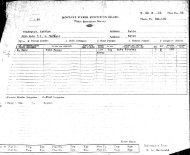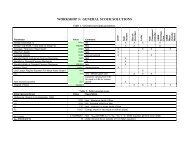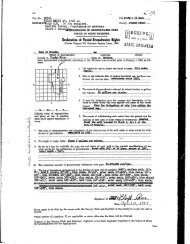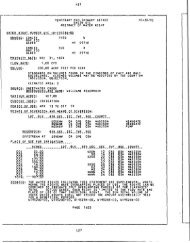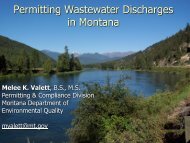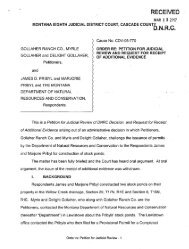Streambank Protection Methods Bio-Engineering Techniques
Streambank Protection Methods Bio-Engineering Techniques
Streambank Protection Methods Bio-Engineering Techniques
You also want an ePaper? Increase the reach of your titles
YUMPU automatically turns print PDFs into web optimized ePapers that Google loves.
<strong>Streambank</strong> <strong>Protection</strong> <strong>Methods</strong><br />
<strong>Bio</strong>-<strong>Engineering</strong> <strong>Techniques</strong><br />
Instructor:<br />
David T. Williams, Ph.D., P.E.<br />
David T. Williams and Associates, Engineers<br />
david@dtwassoc.com
<strong>Bio</strong>engineering<br />
**? What Are You Trying To Do? **<br />
Did I Mention, Function-based Design?<br />
PROBLEMS: For rills & gullies from overland flow, strong and<br />
dense rooted ground covers or grasses might function well.<br />
Use pioneer species that will stabilize the bank and evolve into<br />
a climax forest?<br />
Plant specific plants for use by specific fauna?<br />
Do you need an understory, mid-story and overstory? Or not?
Do you need no mid-story for woodpecker flyways?<br />
Will the overstory shade out the understory?<br />
Vegetative roughness or living dikes to reduce flow<br />
velocities & catch sediment?<br />
Do you need shade and canopy over the stream?<br />
Microhabitats?<br />
Insect production for the stream?<br />
Tall vegetation and canopy to keep cool moist air over the<br />
stream?<br />
Flood concerns? Use herbaceous plants!?!?
<strong>Bio</strong>engineering Planting Considerations<br />
First look up, then look down, (up to analyze for amount of light<br />
and overhead power lines, down for suitable soil & pipeline right-ofways),<br />
then look around for exotic plant competition, and where (or<br />
if) the plants of choice are growing naturally.<br />
Plants on opposite banks might grow in different elevation bands.<br />
If plants are not found naturally, why?<br />
Plant materials obtained through commercial growers, NRCS plant<br />
material centers, grown in-house, or harvested from the wild.<br />
Harden-off rooted-stock plants (place outside greenhouse) before<br />
planting.
<strong>Bio</strong>engineering Planting Considerations<br />
Harvested cuttings should be kept moist/out of direct sunlight.<br />
Some cuttings benefit from soaking (up to 31 days for Black<br />
Willow). Water that plants are soaked in should be fresh.<br />
Very important to have good soil-to-stem contact, this must be<br />
carefully specified in contracts<br />
Plantings need to be closely monitored for insect infestation and<br />
mortality, some replanting can be expected during the second<br />
growing season.<br />
Is irrigation needed? Weed control? Browsing control?
Advantages of Vegetation<br />
Filters runoff<br />
Safer than riprap - less chance of contact injury<br />
Aesthetically pleasing<br />
Improved wildlife habitat
Advantages of Vegetation<br />
Improved fish habitat (cover food, shade)<br />
Enhanced passive recreational activities<br />
Source of carbon matter to the stream system<br />
Canopy helps to lower water temperatures and reduce<br />
soil erosion<br />
No graffiti (actually not always)
Environmental Functions of<br />
Vegetative Bank <strong>Protection</strong> Structures<br />
Provide cover.<br />
Stabilize or lower water and air temperatures .<br />
Trap cool moist air moving (traveling) immediately above water.<br />
Maintain dissolved oxygen levels.<br />
Supply carbon material to the stream (leaf litter, debris, SWD &<br />
LWD).<br />
Provide habitat, food and shelter for insects and other critters,<br />
nesting areas, migration corridors, cover from predators, & other<br />
good riparian buffer zone features.
Environmental Functions of<br />
Vegetative Bank <strong>Protection</strong> Structures<br />
Provide nutrient uptake and long-term storage of nutrients &<br />
contaminants<br />
Trap sediment, reducing sediment load to stream<br />
Reduce water content of bank, drier banks are usually more<br />
stable<br />
NOTE: Stream stabilization might not necessarily be good for<br />
terrestrial habitat diversity. With time, all riparian areas could<br />
become climax communities & vegetative diversity and<br />
complexity would be reduced.
Uncontrolled Variables<br />
That Affect Vegetation<br />
Soil types - highly erodible, acidic, anaerobic, etc.<br />
Soil heterogeneity<br />
Climate<br />
Rainfall distribution - space and time<br />
Temperature<br />
Season
Elevation<br />
Uncontrolled Variables<br />
That Affect Vegetation<br />
Competition from other plants and noxious weeds<br />
Vegetative succession<br />
Maintenance<br />
Stream variables - flood events, stages, durations, velocities<br />
IMPORTANT NOTE: Engineers and others need to<br />
understand that growing vegetation is complex and not<br />
every plant will live and grow.
Urban Soils<br />
In many cases reclamation, not revegetation (no vegetation<br />
to begin with, only bare soils).<br />
Soils are typically disturbed.<br />
Relatively sterile - little or no organic material.<br />
Composed of subsoils, not top soils.<br />
pH can be high, low, or neutral.<br />
Can be located in very inhospitable areas (chemical<br />
pollution, thermal pollution, etc.)
Why Some Folks Are<br />
Reluctant to Use Vegetation<br />
Both plant biological needs and hydraulic design parameters for<br />
plants must be met.<br />
Knowledge of hydraulic design parameters or limits for plants is<br />
currently incomplete.<br />
Known hydraulic parameters change with experience/failures<br />
Vegetation is not always immediately effective.<br />
Everything listed on the "Uncontrolled Variables that Affect<br />
Vegetation" slide.<br />
Participating agencies, designers, contractors, and/or inspectors<br />
might not have much, or any, experience with vegetative fixes.
How Vegetative Treatments<br />
Stabilize Banks<br />
Foliage slows floodwaters on and near the eroding bank.<br />
Root network helps to bind soil together.<br />
Trunks and stems can trap debris and upslope failed material.<br />
Vegetation removes soil moisture through transpiration.<br />
Larger branches/trunks planted deep can sometimes<br />
mechanically stabilize soil and could pin shallow failure faults.<br />
Can induce sedimentation.<br />
Most importantly, the resulting stable bank allows for the<br />
establishment of volunteer plant growth and subsequent<br />
vegetative succession.
<strong>Bio</strong>engineering <strong>Methods</strong><br />
Consider integrating when stone is placed or retrofitting existing<br />
projects: Soil "choked" & seeded riprap with rooted stock plants in<br />
interstecies<br />
Live Staking and Joint Planting<br />
Brush Layering, Brush Layering with Rock Toe<br />
Bent Willow Pole Method<br />
Live Wattles (branches every which-a-way), Live Fascines (branches<br />
bundled in one direction only), and Reinforced Wattles and Fascines<br />
Turf Reinforcement Mats (TRM’s) and Erosion Control Blankets (ECB’s)
<strong>Bio</strong>engineering <strong>Methods</strong><br />
Coir Fiber Rolls and Mats (including pre-seeded and pre-grown)<br />
Brush Mattress<br />
Tree Revetments (Cedar Tree Revetments)<br />
Live Siltation combined with LPSTP<br />
Dormant Willow Post Method<br />
Willow Poles and Willow Curtains<br />
Debris Dikes and Living Dikes (sediment catchers and velocity<br />
reducers)
Soil-Choked<br />
RIPRAP<br />
From John McCullah’s<br />
www.E-SenSS.com
Live Staking<br />
(Also Called "Sprigging", Pencils" or "Whips")<br />
Description: Manual vertical insertion of small sharpened<br />
willow cuttings (branches 18 to 30 inches in length, 1/2 to 3/4<br />
inch diameter) in the lower sections of stream banks. Can either<br />
be pushed in by hand or a tile probe can be used to poke a hole<br />
in the bank with the branch inserted in the hole. Can be placed<br />
in and around bioengineering projects or "hard" structures.<br />
No mechanized support needed.<br />
Inexpensive, simple, versatile, and quick!<br />
No material cost items.<br />
Two man crew can install up to 500 sprigs a day.<br />
Can be planted from on-bank or canoe.
Joint Planting is the<br />
same as Live Staking<br />
except it is driven<br />
through or integrated<br />
into the riprap or other<br />
armor (through the<br />
joints or interstecies of<br />
the armor material)
Weighted toe, designed to<br />
self-adjust into scour hole<br />
Joint Plantings<br />
VEGETATED RIPRAP<br />
w/ BRUSHLAYERING,<br />
POLE PLANTING,<br />
& JOINT PLANTING
Individual poles pulled up & growing<br />
This method<br />
invented by<br />
Chris Hoag
The Bent Willow Pole Method<br />
A John McCullah invention<br />
This technique is used to integrate large willow poles behind<br />
(landward of) a riprap protection scheme<br />
Poles can be laid on the bank (butt ends in water or vadose<br />
zone), covered with riprap, the upper ends bent to a vertical<br />
position, then rocks wedged behind pole to keep pole oriented<br />
vertically<br />
Allows willows to grow in some areas (UP BANK) where naturally<br />
might be too dry for vigorous willow growth
This method<br />
invented by John<br />
McCullah!
Riprap can also be choked with<br />
soil for better rooting<br />
Self-Adjusting, Self-<br />
Filtering Stone can<br />
also be used in this<br />
application
LIVE FASCINES<br />
Always placed on a<br />
slope, branches in<br />
fascine bundle are all<br />
oriented in the same<br />
direction, tips angled<br />
upslope, butt ends<br />
positioned downslope
Note sediment<br />
landward of<br />
coir roll just<br />
days after<br />
construction,<br />
note pre-grown<br />
black willow<br />
trees in roll, all<br />
drowned due<br />
to DS beaver<br />
dam backwater
<strong>Bio</strong>engineering Top 11 Cheat Sheet<br />
1. Dig a hole, plant a pole!!! McCullah’s mantra for the bioengineer.<br />
2. For unrooted stock, plant 80% in soil, 20% out.<br />
3. Good stem to soil contact is critical, tamp and WATER<br />
MATERIAL IN!!<br />
4. Use a variety of techniques and plant materials and material sizes<br />
5. No starter rills, mulch if needed<br />
6. Plant the keys with both large and small material.
<strong>Bio</strong>engineering Top 11 Cheat Sheet<br />
7. No “Droopers” - all plantings should be angled at 10-20 degrees<br />
above horizontal or more.<br />
8. Use dense rows of plants to trap sediment and/or act as "living<br />
dikes“<br />
9. What type and where was historical vegetation located in the<br />
system?<br />
10. Consider herbaceous plants (sedges, reeds, emergent aquatics,<br />
etc.)<br />
11. If needed, and if possible, use BIODEGRADABLE Turf<br />
Reinforcement Mats and Erosion Control Blankets.
The Dormant<br />
Willow Post<br />
Method, and<br />
Willow Poles<br />
(Various Styles)
Advantages of Planting Willows<br />
Early or Late in the Dormant Season<br />
EARLY<br />
Willows put energy into growing roots (at least until ground<br />
temperature reaches approximately 45 degrees or colder)<br />
Ground not frozen.<br />
Consider interaction of plants with ice (shear and lifting)<br />
LATE<br />
Less chance of ice damage.<br />
Less chance of beaver damage.<br />
NOTE: Carefully weigh advantages and disadvantages for your<br />
particular situation and area of the country.
The Willow Curtain Method<br />
Description: Horizontal placement of anchored willow tree trunks in a<br />
shallow trench positioned near water's edge. Can be placed on benched<br />
areas at heights just above the low-flow water surface elevation or on the<br />
point bar (in low sections or near the edge) to increase flow resistance and<br />
reduce the impact of concentrated flow on the eroding outer bank.<br />
Can be accomplished with no mechanized support.<br />
Very inexpensive, simple to understand and execute, and quick!<br />
Anchor with dead stout stakes or live stakes.<br />
Five 20 ft. long willows will cover 100 ft of stream bank.<br />
A two man crew installed 300 lineal ft. of curtains in 3 hours.<br />
Need to be installed in areas with sufficient moisture.<br />
This WES developed technique is currently considered experimental.<br />
From Dave Derrick, USACE, ERDC
Inexpensive, simple, and quick!<br />
Willow Pole Method<br />
Description: Anchored willow tree trunk placed with the butt end buried<br />
below the water surface at the toe of the eroding bank, trunk positioned upbank<br />
in a shallow trench. Water is supplied at base, roots grow from trunk<br />
which is in contact with the soil all the way up the bank, with branches<br />
sprouting along the entire length of the "up" side of the trunk.<br />
On eroding banks should be used in combination with redirective methods or<br />
toe protection.<br />
Can be accomplished with no mechanized support, excellent for areas<br />
where equipment access is limited or prohibited.<br />
Expensive auguring equipment is not needed.<br />
Anchor with dead stout stakes or live stakes.<br />
This WES developed technique is currently considered experimental.<br />
From Dave Derrick
Be Aware of Vegetative<br />
Maintenance Regulations<br />
COE ETL 1110-2-571: Guidelines for Landscape<br />
Planting and Vegetation Management at Levees,<br />
Floodwalls, Embankment Dams, and Appurtenant<br />
Structures (2009)<br />
State and Local Regulations







